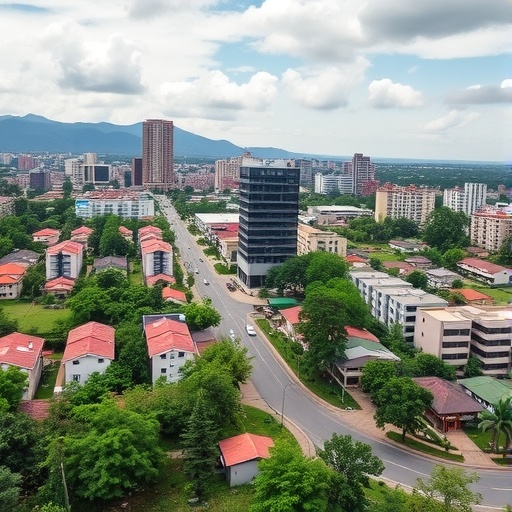Urban growth represents a double-edged sword in the context of developing regions. On the one hand, it symbolizes progress, opportunity, and improved living standards. On the other hand, unchecked expansion can lead to significant environmental degradation, particularly in densely populated areas. The Gasabo District in Rwanda serves as a critical case study that highlights these dynamics. Recent research conducted by Ernest Tuyishime and colleagues delves deeply into the intricacies of managing urban growth while simultaneously protecting the environment. Their findings underscore the urgency of adopting sustainable practices within urban planning paradigms to mitigate the adverse consequences of rapid urbanization.
A defining feature of urban growth is its rapid nature, fueled predominantly by an influx of migrants seeking better economic prospects. Such demographic shifts result in burgeoning populations placing immense strain on local resources—land, water, and energy. In the Gasabo District, these changes have brought to the fore the challenge of balancing development needs with environmental stewardship. Researchers emphasize that without strategic intervention, the pressure from urban expansion could compromise ecologically sensitive areas, leading to biodiversity loss and deterioration of environmental quality.
The study conducted by Twizerimana et al. meticulously outlines various strategies that local governments and stakeholders can employ to manage urban growth sustainably. One key recommendation involves the implementation of comprehensive land-use planning that integrates environmental considerations into the decision-making process. This entails not merely zoning laws but also employing tools such as environmental impact assessments to ensure that developments align with sustainable practices.
Moreover, community engagement is identified as a crucial element in fostering sustainable urban growth. The researchers suggest that involving local populations in the planning process can create a sense of ownership and responsibility toward their environment. When communities are empowered to voice their concerns and contribute ideas, urban planners are better equipped to make informed decisions that reflect the needs and aspirations of the residents. This participatory approach may also facilitate more robust environmental protection measures by increasing awareness and advocacy among the populace.
Another critical aspect of managing urban growth highlighted in the study is the promotion of green infrastructure. This concept refers to a network of natural and semi-natural features designed to provide environmental, economic, and social benefits. Examples include green roofs, parks, permeable pavements, and urban forests, which can enhance air quality, reduce urban heat, and improve stormwater management. The implementation of such infrastructure not only boosts the resilience of urban areas against climate change but also contributes to the aesthetic and recreational value of the communities.
Furthermore, the study spotlights the potential of integrating technology into urban management practices. Innovations such as smart city technologies can streamline resource usage, improve public transport efficiency, and facilitate real-time monitoring of environmental quality. Smart solutions can provide valuable data for urban planners to optimize various aspects of city life, ensuring that the demands of urbanization do not compromise environmental integrity.
As urban areas continue to evolve, the preservation of green spaces becomes more pertinent. The researchers argue that maintaining these areas is not merely a luxury but a necessity for sustainable urban living. Green spaces serve as vital ecosystems that support biodiversity, provide recreational opportunities, and contribute to residents’ psychological well-being. Policies aiming to protect and expand these spaces are therefore essential components of an effective urban growth management strategy.
In addressing the challenges posed by urban expansion, the study calls for a multi-sectoral approach to sustainability. Collaboration among various stakeholders—government agencies, private sectors, non-governmental organizations, and communities—is pivotal in crafting cohesive policies that effectively tackle urbanization’s multifaceted issues. This partnership approach fosters a culture of shared responsibility, ensuring that efforts to manage urban growth are comprehensive and inclusive.
Equally significant is the recognition of climate change as an existential threat exacerbated by urban growth. The effects of climate change, such as rising temperatures and extreme weather events, place additional burdens on urban areas already grappling with resource limitations. Therefore, integrating climate resilience into urban planning is not optional but essential. Strategies should encompass adaptive measures that anticipate future climate challenges and enable cities to withstand them, ensuring that growth does not come at the expense of ecological vitality.
In summary, Twizerimana, Tuyishime, and Uwizeyimana’s research presents a compelling case for the necessity of sustainable management practices in urban growth scenarios, particularly within the context of Rwanda. The Gasabo District exemplifies the pressing need to harmonize development with environmental protection, demonstrating that thoughtful planning and community engagement can create sustainable urban environments. As cities worldwide face the repercussions of rapid urbanization, lessons from this research can provide valuable insights into constructing more resilient, sustainable urban landscapes. Ultimately, the paradox of urban growth transcends mere development, pushing humanity to reconsider our relationship with the environment and redefine progress in the twenty-first century.
Subject of Research: Managing urban growth and protecting the environment in Gasabo District, Rwanda.
Article Title: Managing urban growth and protecting the environment in Gasabo District, Rwanda.
Article References:
Twizerimana, S., Tuyishime, E. & Uwizeyimana, J. Managing urban growth and protecting the environment in Gasabo District, Rwanda.
Discov Sustain 6, 1277 (2025). https://doi.org/10.1007/s43621-025-02117-5
Image Credits: AI Generated
DOI: https://doi.org/10.1007/s43621-025-02117-5
Keywords: Sustainable urban growth, environmental protection, Gasabo District, Rwanda, urban planning, green infrastructure, community engagement, climate resilience.




